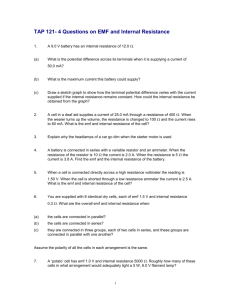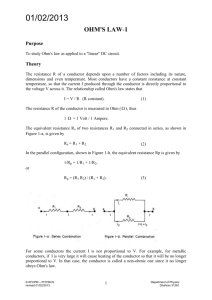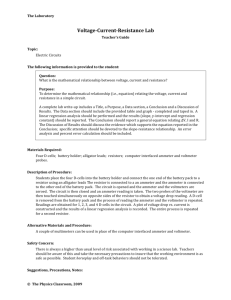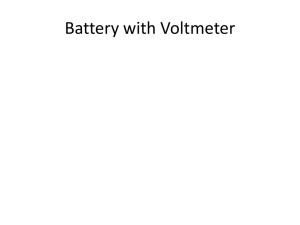Ohm's Law
advertisement
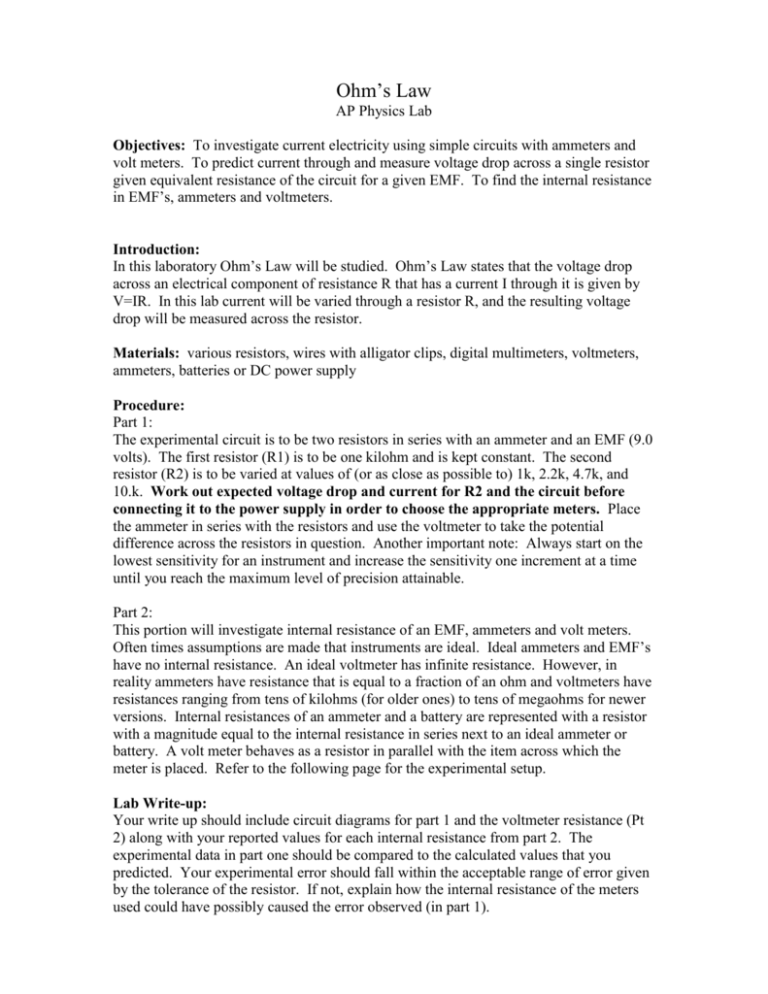
Ohm’s Law AP Physics Lab Objectives: To investigate current electricity using simple circuits with ammeters and volt meters. To predict current through and measure voltage drop across a single resistor given equivalent resistance of the circuit for a given EMF. To find the internal resistance in EMF’s, ammeters and voltmeters. Introduction: In this laboratory Ohm’s Law will be studied. Ohm’s Law states that the voltage drop across an electrical component of resistance R that has a current I through it is given by V=IR. In this lab current will be varied through a resistor R, and the resulting voltage drop will be measured across the resistor. Materials: various resistors, wires with alligator clips, digital multimeters, voltmeters, ammeters, batteries or DC power supply Procedure: Part 1: The experimental circuit is to be two resistors in series with an ammeter and an EMF (9.0 volts). The first resistor (R1) is to be one kilohm and is kept constant. The second resistor (R2) is to be varied at values of (or as close as possible to) 1k, 2.2k, 4.7k, and 10.k. Work out expected voltage drop and current for R2 and the circuit before connecting it to the power supply in order to choose the appropriate meters. Place the ammeter in series with the resistors and use the voltmeter to take the potential difference across the resistors in question. Another important note: Always start on the lowest sensitivity for an instrument and increase the sensitivity one increment at a time until you reach the maximum level of precision attainable. Part 2: This portion will investigate internal resistance of an EMF, ammeters and volt meters. Often times assumptions are made that instruments are ideal. Ideal ammeters and EMF’s have no internal resistance. An ideal voltmeter has infinite resistance. However, in reality ammeters have resistance that is equal to a fraction of an ohm and voltmeters have resistances ranging from tens of kilohms (for older ones) to tens of megaohms for newer versions. Internal resistances of an ammeter and a battery are represented with a resistor with a magnitude equal to the internal resistance in series next to an ideal ammeter or battery. A volt meter behaves as a resistor in parallel with the item across which the meter is placed. Refer to the following page for the experimental setup. Lab Write-up: Your write up should include circuit diagrams for part 1 and the voltmeter resistance (Pt 2) along with your reported values for each internal resistance from part 2. The experimental data in part one should be compared to the calculated values that you predicted. Your experimental error should fall within the acceptable range of error given by the tolerance of the resistor. If not, explain how the internal resistance of the meters used could have possibly caused the error observed (in part 1). Determining the internal resistance of voltmeters, ammeters and EMF’s: Ammeters: Use 0.5 volts as the potential difference and resistance can be varied to be the 5 lowest resistors available. The ammeter will be set on the required setting so that the predicted current will fall within the range of the ammeter. You will then measure the voltage drop across the ammeter and record it in the table. Resistor Current VA Now you will measure the internal resistance of voltmeters: In order to do this you will have to use one of the analogue voltmeters. The expected resistance is on the order of 10’s of K’s. Design a procedure to measure voltage drop across a single resistor and the current in the circuit. Measure the current with and without the voltmeter and calculate the equivalent resistance of the circuit with the voltmeter in parallel to the known resistor. Solve for the resistance of the voltmeter in each case. Use resistances on the order of 10’s of kilohms in your design. Record your data in the table below. Resistor ( Current (A) Voltage drop (V) New Current (A) EMF’s The terminal voltage, VT, of an EMF is the potential difference across the terminals of the EMF when current is passing through it. Terminal voltage should always be used in place of EMF because any time an EMF is delivering current some of the energy per unit charge is consumed in driving current through the EMF itself. This is known as internal resistance: Rint VT = EMF – Rint I You will find the internal resistance of the EFM you use by varying current through the EMF by running current through varying resistance for a 9 volt EMF. A potentiometer (or rheostat) will be used to accomplish this. You will measure the voltage drop across the EMF with a voltmeter to get the terminal voltage and you will use the equation listed above to calculate internal resistance. What is the maximum resistance (rmax) for the rheostat? _____________ % rmax 25 50 75 100 R I VT


